- IRS forms
- Form 2290
Form 2290: Heavy Highway Vehicle Use Tax Return
Download Form 2290If you own heavy vehicles and use them on public highways, you are likely familiar with the Heavy Highway Vehicle Use Tax. The Internal Revenue Service (IRS) requires the payment of this tax by owners of vehicles with a gross weight of 55,000 pounds or more. To fulfill this requirement, you must file Form 2290, also known as the Heavy Highway Vehicle Use Tax Return.
Form 2290 is a tax form used to report and pay the Heavy Highway Vehicle Use Tax. It is an annual tax imposed on vehicles operating on public highways with a gross weight of 55,000 pounds or more. The tax revenue collected through Form 2290 is utilized to maintain and improve the nation's highway infrastructure.
In this blog post, we will provide a detailed overview of Form 2290 and guide you through the process of filing this important tax return.
Purpose of Form 2290
The purpose of Form 2290 is to fulfill the tax obligations imposed by the Internal Revenue Service (IRS) for the use of heavy vehicles on public roads.
Here are the main purposes of Form 2290:
Reporting taxable vehicles: Form 2290 is used to report information about taxable vehicles, which includes trucks, tractors, and buses that have a gross weight of 55,000 pounds or more and are expected to travel 5,000 miles or more during the tax period.
Calculating and paying the tax: The form helps in calculating the amount of federal excise tax owed based on the taxable vehicles' weight and usage. The tax rate varies depending on the vehicle's weight category. The tax is typically paid annually, and the tax period runs from July 1 to June 30 of the following year.
Filing and recordkeeping: Form 2290 serves as a recordkeeping tool for both the IRS and the vehicle owners/operators. By filing this form, taxpayers provide necessary information about their vehicles and their tax liabilities. It helps the IRS maintain accurate records of heavy highway vehicle use and enforce compliance with tax regulations.
**Proof of payment: **Form 2290 provides proof of payment of the federal excise tax. Once the form is processed by the IRS and the tax is paid, the taxpayer receives a stamped Schedule 1, which serves as proof of payment and must be carried in the vehicle as evidence that the tax has been paid.
Benefits of Form 2290
Here are a few advantages of Form 2290:
-
Compliance with tax regulations: Filing Form 2290 ensures that you are complying with the tax regulations set by the IRS. It allows you to fulfill your tax obligations related to the use of heavy vehicles on public highways, avoiding potential penalties and legal issues.
-
Proof of payment: By filing Form 2290 and receiving a stamped Schedule 1, you obtain proof of payment for the federal excise tax. This document serves as evidence that you have fulfilled your tax liability and can be useful for various purposes, such as vehicle registration and obtaining permits.
-
Highway maintenance and development: The federal excise tax collected through Form 2290 is used for highway maintenance, improvements, and development projects across the country. By paying this tax, you contribute to the upkeep and enhancement of public highways and infrastructure that facilitate transportation and commerce.
-
Compliance with state requirements: Many states require a copy of the stamped Schedule 1 from Form 2290 as proof of payment of the federal excise tax to register or renew the registration of heavy vehicles. Filing Form 2290 ensures that you have the necessary documentation to meet state registration requirements for your vehicles.
-
Avoiding penalties and interest: Failing to file Form 2290 or pay the required tax can result in penalties and interest charges imposed by the IRS. By timely filing and paying the tax, you can avoid these additional costs and penalties, saving you from unnecessary financial burdens.
-
Proper record-keeping: Filing Form 2290 helps you maintain accurate records of your heavy vehicles and their tax liabilities. This can be beneficial for financial management, tax planning, and audits. Having organized records can also make it easier to comply with other tax and regulatory requirements related to your vehicles.
Who Is Eligible To File Form 2290?
The following entities are typically eligible to file Form 2290:
Owner-operators: Individuals who own and operate a heavy vehicle(s) weighing 55,000 pounds or more and use it for business purposes
**Trucking companies: **Businesses that own and operate heavy vehicles for business purposes
Agricultural vehicles: Vehicles used primarily for farming and agricultural purposes are eligible for a reduced HVUT rate if they travel fewer than 7,500 miles (or 5,000 miles for vehicles used by a farm vehicle operator) during the tax period.
It's important to note that the above list is not exhaustive, and there may be additional situations where Form 2290 needs to be filed.
How To Complete Form 2290: A Step-by-Step Guide
Form 2290 is the IRS form used for reporting and paying the Heavy Highway Vehicle Use Tax (HVUT) for vehicles with a gross weight of 55,000 pounds or more.
Here's a step-by-step guide on how to complete Form 2290:
Step 1: Gather information
Collect the necessary information for filing Form 2290. This includes:
- Your Employer Identification Number (EIN)
- Vehicle identification number (VIN)
- Gross weight of the vehicle
- Taxable gross weight of the vehicle
- First used month of the vehicle
Step 2: Download the form
Visit the official IRS website or use tax software approved by the IRS to download Form 2290.
Step 3: Provide general information
Fill out the general information section of Form 2290, which includes your name, address, and EIN. Indicate whether you are filing as an individual or a business.
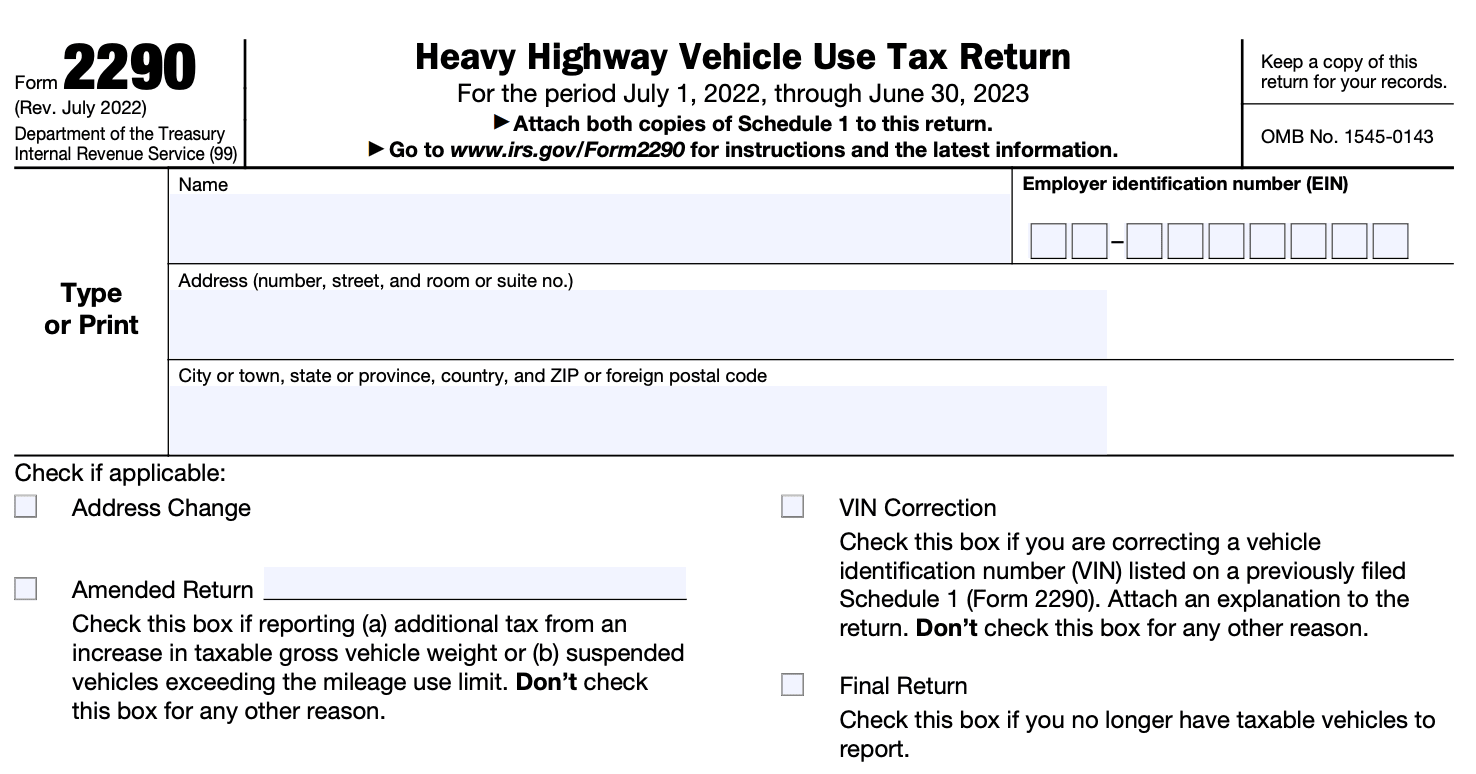
Step 4: Enter vehicle details
Enter the details of each vehicle for which you are paying the HVUT. This includes the VIN, taxable gross weight, and first used month of each vehicle. If you have more than one vehicle, you can either provide the details on the form or attach a separate sheet with the information.
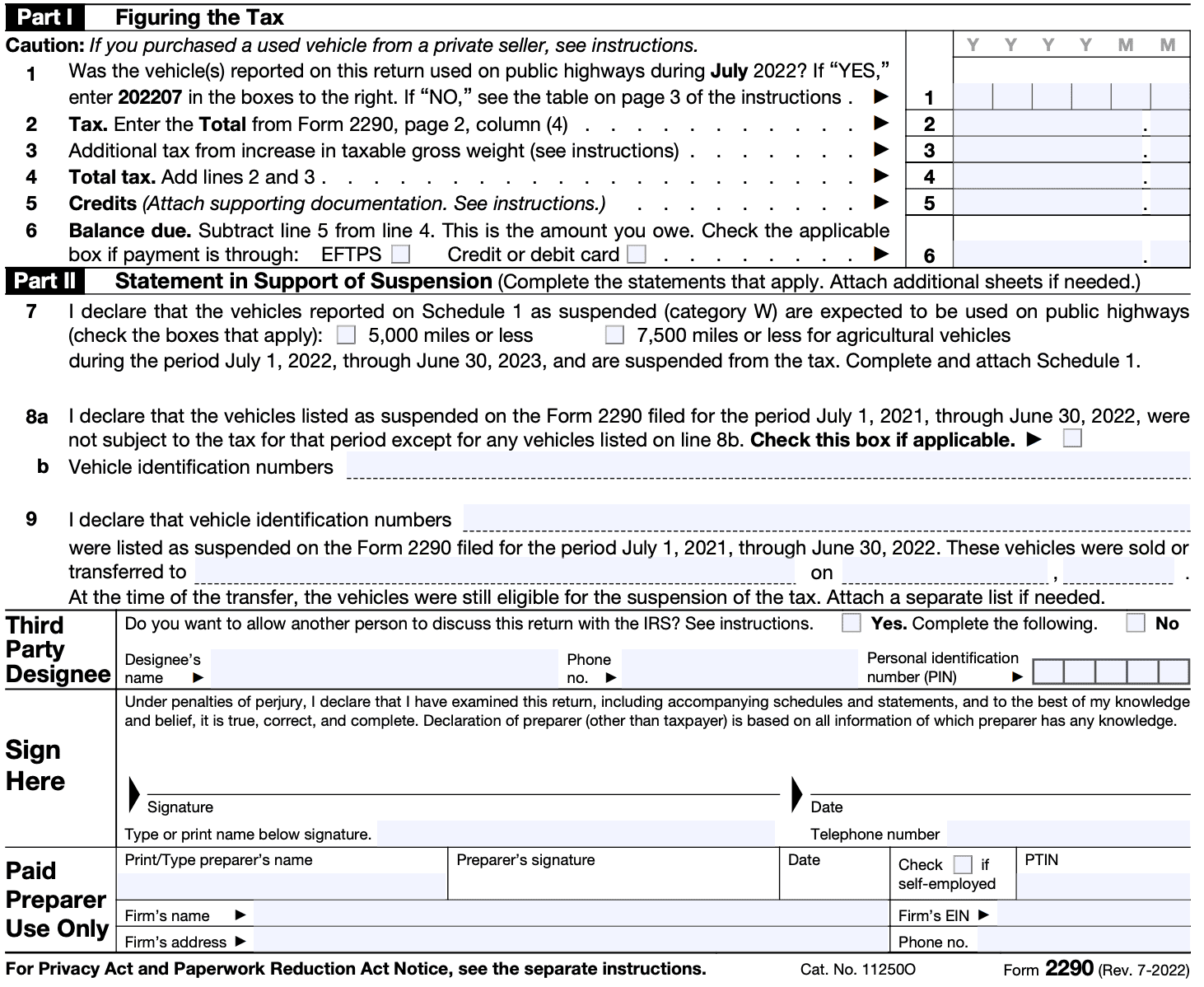
Step 5: Calculate tax
Use the tax table or the IRS tax calculator to determine the amount of tax you owe based on the taxable gross weight and first used month of each vehicle.
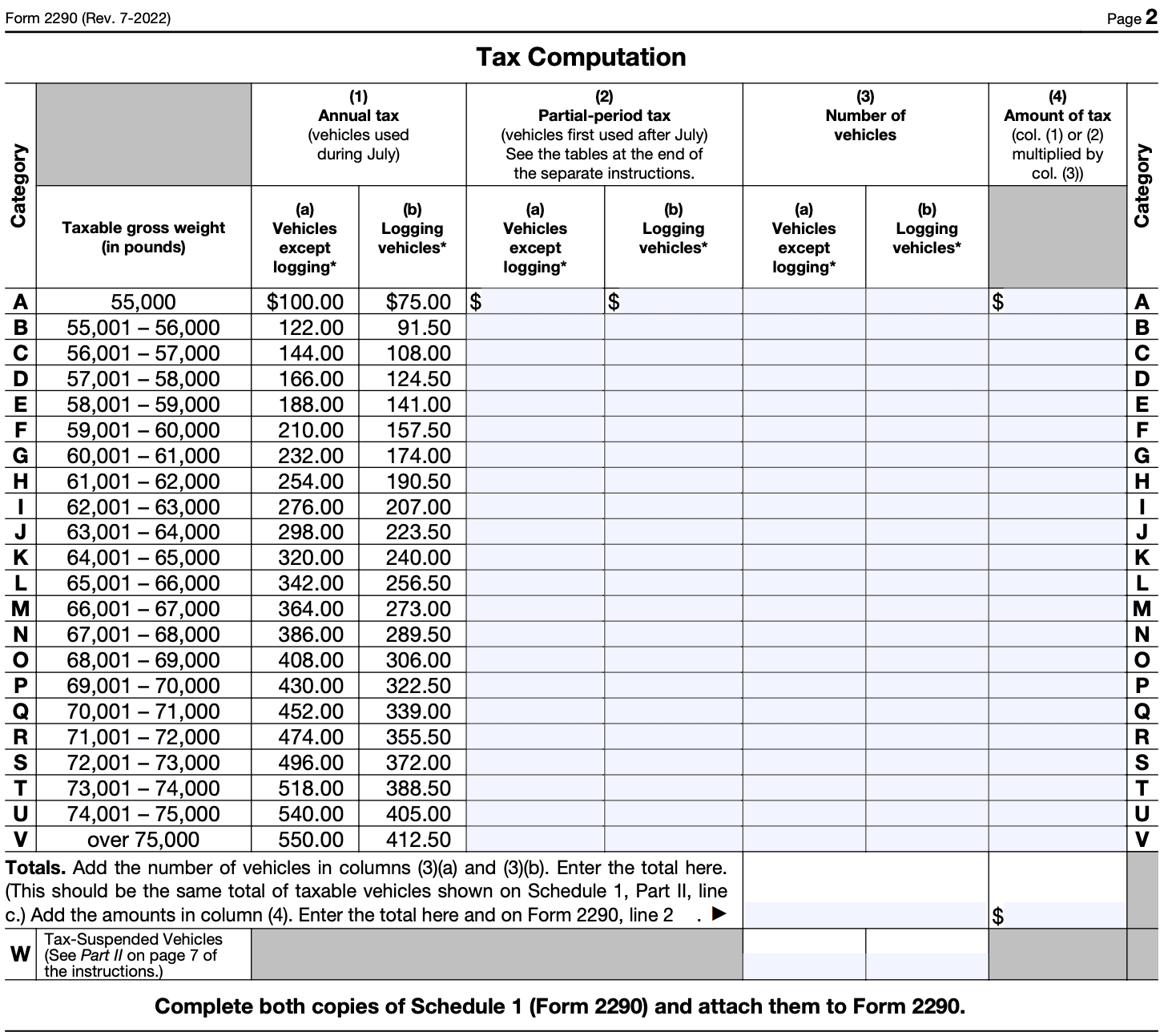
Step 6: Report suspended vehicles
If you have any vehicles that are exempt from the HVUT due to limited usage (e.g., agricultural vehicles or vehicles with low mileage), report them in the suspended vehicles section of Form 2290.
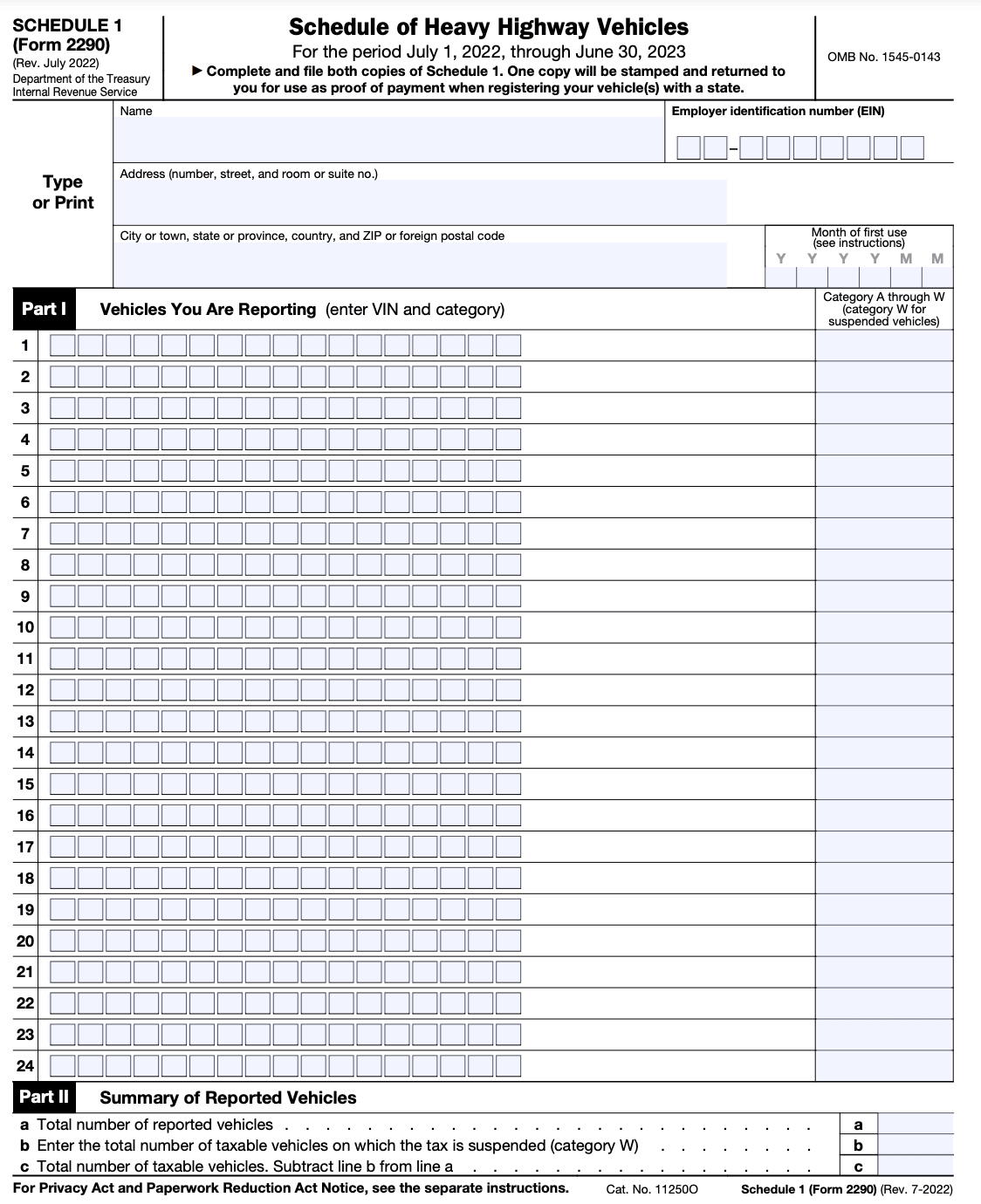
Step 7: Sign and date
Sign and date the completed form to certify that the information provided is accurate.
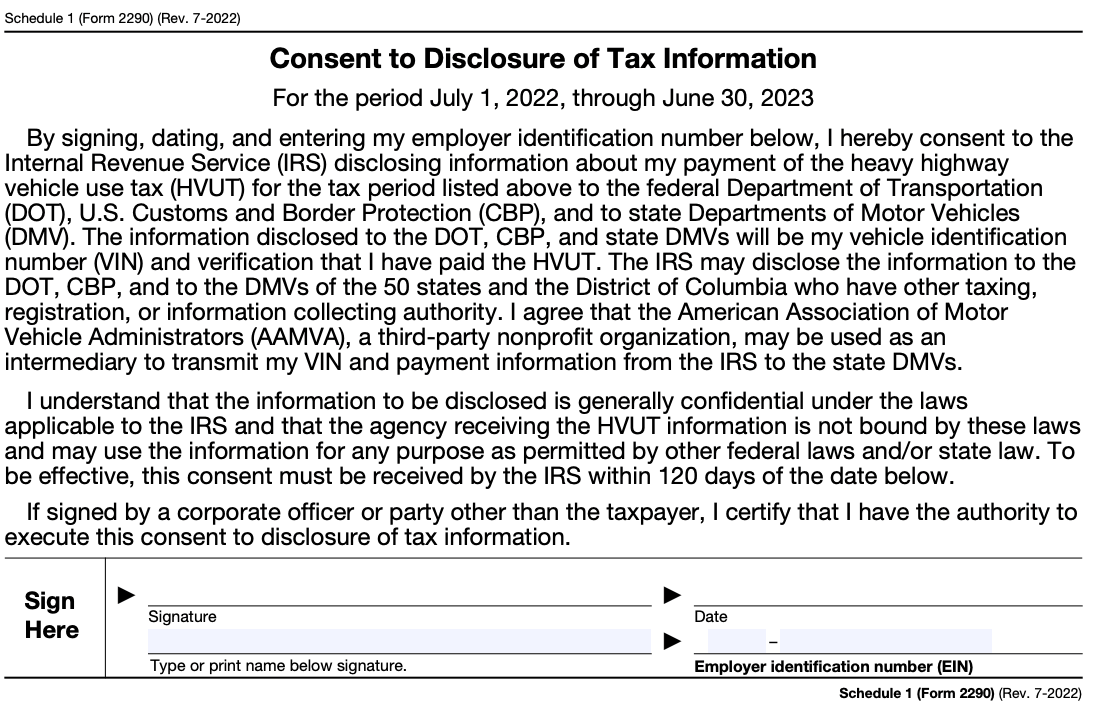
Step 8: Make payment
Calculate the total tax amount for all the vehicles and make the payment. You can pay electronically using the Electronic Federal Tax Payment System (EFTPS), by credit or debit card, or by check or money order.
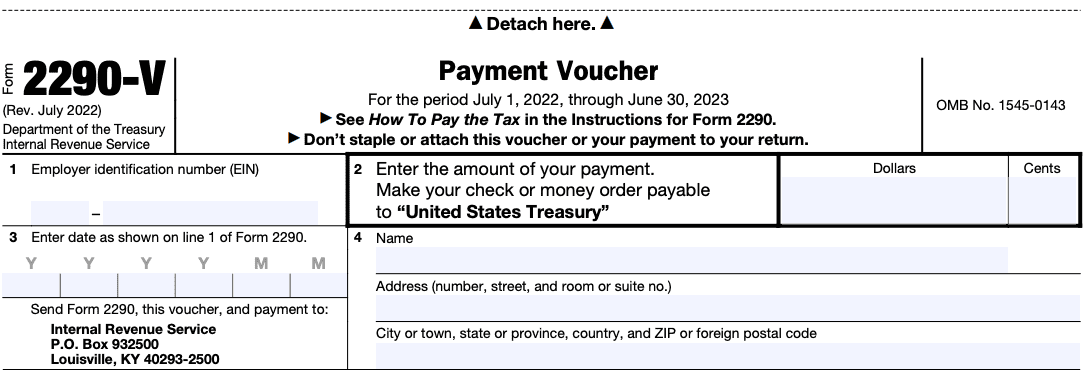
Step 9: Submit Form 2290
Mail the completed and signed Form 2290 along with any payment voucher and payment to the appropriate IRS address based on your location. Alternatively, you can file electronically through an authorized e-file provider.
Step 10: Keep a copy
Make a copy of the completed Form 2290, payment voucher, and payment receipt for your records. It is important to retain these documents for at least three years.
Remember to check the IRS website or consult a tax professional for the most up-to-date instructions and requirements related to filing Form 2290, as the process may change over time.
Special Considerations When Filing Form 2290
When filing Form 2290, there are several special considerations you should keep in mind. Here are some important points to consider:
Taxable vehicles: Form 2290 is applicable to heavy vehicles with a gross weight of 55,000 pounds or more that are used on public highways. However, there are certain types of vehicles that are exempt from this tax, such as agricultural vehicles, government vehicles, and vehicles used for logging.
E-filing requirement: If you are reporting 25 or more vehicles on Form 2290, you are required to e-file the return. The IRS encourages all taxpayers to e-file as it is a faster and more convenient method.
Employer Identification Number (EIN): You must have a valid EIN to file Form 2290. You cannot use your Social Security Number (SSN) for this purpose. If you don't have an EIN, you can apply for one through the IRS website.
Filing deadlines: The regular filing deadline for Form 2290 is August 31 of each year for the tax period starting on July 1 and ending on June 30 of the following year. If the due date falls on a weekend or federal holiday, the deadline is extended to the next business day. It's important to file and pay your taxes on time to avoid penalties and interest.
Tax payment options: There are various payment methods available for paying the Heavy Highway Vehicle Use Tax. You can pay electronically through the Electronic Federal Tax Payment System (EFTPS), by credit or debit card, or by check or money order.
**Vehicle information: **When filing Form 2290, you'll need to provide detailed information about each taxable vehicle, including its identification number (VIN), taxable gross weight, and the month of first use. Make sure to accurately report this information to avoid any discrepancies.
Mileage limit for suspended vehicles: If a vehicle is expected to be used 5,000 miles or less (7,500 miles or less for agricultural vehicles) during the tax period, it may be eligible for a reduced tax rate or exemption. However, you still need to file Form 2290 to report the vehicle.
Recordkeeping: It's crucial to maintain proper records of your Form 2290 filings and related documents for at least three years. This includes proof of payment, stamped Schedule 1, and any supporting documentation.
Filing Deadlines & Extensions for Form 2290
The following information provides general guidelines about the filing deadlines and extensions for Form 2290. However, it's essential to consult the latest information from the Internal Revenue Service (IRS) or a tax professional for the most up-to-date details.
Filing deadline
The regular filing deadline for Form 2290 is August 31 of each year. This deadline applies to vehicles that are first used on the road during July. The tax period for Form 2290 runs from July 1 to June 30 of the following year.
Extensions
The IRS allows a one-month extension for filing Form 2290 if you need additional time to prepare and submit your return. To request an extension, you must submit Form 4868, Application for Automatic Extension of Time to File U.S. Individual Income Tax Return, to the IRS by the regular filing deadline (August 31). This extension moves the deadline to September 30.
Payment deadline
Regardless of whether you file by the regular deadline or obtain an extension, the HVUT payment is still due by August 31. If you fail to make the payment on time, penalties and interest may apply.
E-filing and payment options
The IRS encourages e-filing for Form 2290, and it is mandatory for taxpayers reporting 25 or more vehicles. When e-filing, you can choose to pay the HVUT electronically through the Electronic Federal Tax Payment System (EFTPS), direct debit, or by check or money order.
Common Mistakes To Avoid While Filing Form 2290
When filing Form 2290, which is used to report and pay the Heavy Highway Vehicle Use Tax, it's important to avoid certain common mistakes. Here are some mistakes to watch out for:
Incorrect or incomplete information: Ensure that all the information provided on the form is accurate and complete. Double-check details like the Vehicle Identification Number (VIN), business name, address, and tax year.
Filing with the wrong tax period: Form 2290 is filed annually for the tax period starting from July 1 and ending on June 30 of the following year. Make sure you're filing for the correct tax period.
Incorrect vehicle information: Provide accurate details for each vehicle, including the VIN, taxable gross weight, and category. Mistakes in these details can lead to penalties and delays in processing.
Overlooking suspended vehicles: If your vehicle is expected to travel less than 5,000 miles (or 7,500 miles for agricultural vehicles) during the tax period, you may qualify for a suspended or reduced tax rate. Ensure you properly indicate any suspended vehicles on the form.
Failure to report mileage exceeding the limit: If a suspended vehicle exceeds the mileage threshold during the tax period, it must be reported and the tax must be paid for that period. Failing to do so can result in penalties.
Incorrect payment information: Double-check your payment information, such as the routing and account numbers if paying via direct debit. Incorrect payment details can lead to failed transactions or delays.
Not keeping adequate records: Maintain accurate records of filed Form 2290s, proof of payment, and any supporting documents for at least three years. This will help in case of future audits or inquiries.
Missing the deadline: The deadline for filing Form 2290 is typically August 31. Failing to file on time can result in penalties and interest charges, so make sure to submit the form before the due date.
Conclusion
Form 2290 is a crucial requirement for owners and operators of heavy vehicles to fulfill their Heavy Highway Vehicle Use Tax obligations. By understanding the key points, adhering to deadlines, and avoiding common mistakes, you can ensure a smooth filing process.
Remember, electronic filing is the recommended method for its convenience and efficiency. If you have any specific questions or concerns regarding Form 2290, it's always best to consult with a tax professional or visit the official IRS website for the most up-to-date information.


